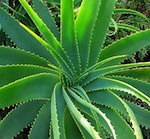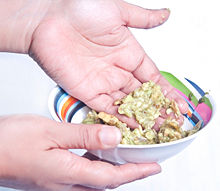There's no scientifically proven way to make your hair grow faster. But, there is a lot of research on what causes hair loss. And the less hair you lose, the more hair you have growing to your length of choice, right? While some of the causes of hair loss can't be helped, there are several things you can do to encourage your hair to grow to its full potential.
Steps
- Keep your hair in excellent condition. Seeing a hairdresser regularly to have your hair cut and styled will keep it in top condition. Hair in good condition gives the impression it's longer even if it's not because it looks good and has no split ends, etc.
- Use a quality brush to keep your hair brushed, such as a boar bristle brush. Tilt your head forward and brush with your head upside down to bring the oils to the ends of your hair and stimulate the scalp.
- Keep your hair well moisturized. You don't need to use commercial product but you do need to know what you can use to condition your hair properly if you resort to natural items.
- Don't wash your hair every day; allow the hair oils to condition your hair rather than constantly washing the oils out.
- Massage your scalp while washing your hair. Massaging your scalp can help your hair grow faster and longer as it increases the blood flow in your scalp.
- Be kind to your hair. Your hair falls out on its own (approximately 70 to 150 hairs daily), but you may be pulling it out faster as a result of the things you do to it. The gentler you are with your hair, the less chances it has to fall out excessively. Some things to keep in mind include:
- Don't put your hair into tight ponytails or cornrows. Use butterfly clips and loose braids instead.
- Brush your hair carefully. If you have wavy or curly hair, there are probably times when you encounter resistance as you're brushing. Right before brushing, use your fingers to gently comb through your hair. And when you brush, start at the ends, and hold the strand you're brushing with your other hand so that if you pull on the hair with a brush, you're not pulling on the root (pull from the grip of your hand instead).
- Brush your hair before you shower in the morning. Throughout the night your hair can knot up a lot. Brushing your hair before you shower reduces tangling when washing it in the shower. When using conditioner, try sifting your fingers through your hair. This reduces extensive combing after your shower and helps to distribute the conditioner evenly.1 day a week put on a good conditioner,hair mascara or a home made conditioner for your hair that could be made of avocado,eggs,oils for 20 mints or 15 and try to not use hair sprays.
- Minimize tangles in other situations, such as on windy days, by containing your hair with buns, braids, hats, etc.
- Minimize how much you style your hair. Any kind of styling that involves pulling your hair at the root (blow drying, using a straight iron or acurling iron, or using rollers) can contribute to hair loss.Heat styling also can encourage hair to break. If you really need to dry your hair fast, use a blow dryer for 5 minutes only.
- Avoid overly long or elaborate extensions or tight hairstyles that tug your natural hair. Pull on it or pull it out too many times and it won't come back.
- Avoid or minimize harsh treatments like dyes, tints, bleaches, straighteners, and permanent waves. These weaken your hair and increase the likelihood of breakage and loss.
- Minimize or stop using heating items on your hair.
- Maintain good nutrition. Your body needs several building blocks in order to produce a healthy head of hair. In particular, you'll need enough protein and vitamins, and you can easily meet your body's requirement by eating a balanced, nutritious diet, or by taking a multivitamin and protein or other appropriate macronutrient supplements consistently if you can't eat well due to illness or otherwise. Keep in mind, however, that it can take several months to notice the results, so don't get discouraged.
- Research suggests that iron deficiency makes hair loss worse. Women with heavy periods are at a higher risk of iron deficiency. However, unless you have an iron deficiency diagnosed by a doctor, you shouldn't take iron supplements. They can upset your stomach and cause severe constipation, and iron overload can be dangerous. Taking a multivitamin and eating iron-rich foods (tofu, lentils, beans, oysters, spinach, prunes, raisins, lean beef) is more than enough.
- If you're a vegetarian, eat foods rich in Vitamin C whenever you eat iron-rich veggies. Vitamin C will help your body absorb the kind of iron that is found in vegetables.
- Avoid purchasing unnecessary supplements such as biotin. Despite the many claims that biotin promotes hair growth, no studies have shown this to be the case. However, hair loss is a sign of severe biotin deficiency; in these cases, the hair loss will be accompanied by a scaly rash around the nose, mouth and genitals.
- Avoid dramatic weight loss. As you shed pounds, you may also shed hair. The dramatic changes that your body undergoes when it loses weight quickly (the change in nutrients, the stress involved) can cause your hair to thin. Diets low in protein and iron (for example, very low-fat diets) and also those high in protein but low in fruits and vegetables (for example, Atkins) that result in dramatic weight loss can also trigger significant hair loss. Instead, keep a balanced diet, and focus on gradual calorie reduction (one or two pounds a week).
- Each hair on your head grows for 2-5 years, slows down for about six weeks, and rests for 3-5 months before falling out so a new hair can grow in its place. Normally, 15 percent of your hair is at the resting phase, but a sudden change in nutrition can cause some hair follicles in the growing phase to switch into the resting phase prematurely, possibly raising the percentage to more than 30 percent.
- Relax. Stress is a common cause of reversible hair loss.When you experience physical or emotional turmoil, it can take anywhere from three weeks to four months for the results to show up in your hair. It is important to relieve your stress.
- Address any pressing health issues. Hair is a strong indicator of overall health. Many nutritional deficiencies can cause hair growth to slow, and can cause hair to thin. Hormonal problems such as hypothyroidism and PCOS can also cause thinning. If your hair has gotten seriously thinner, or stops growing for more than a few months, discuss it with your doctor as soon as possible.























